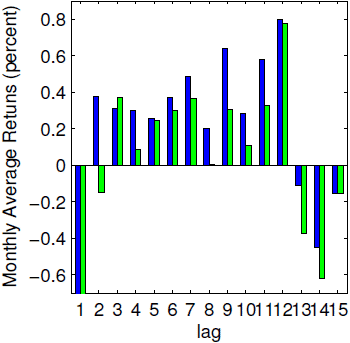Momentum strategies generally consider returns over past months up to one year ago in constructing signals for future abnormal returns. Is some part of that 12-month history more important than others? Might returns from more than a year ago be informative? In the November 2009 version of his paper entitled “Is Momentum Really Momentum?”, Robert Novy-Marx parses the effectiveness of past returns as indicators of future returns by age from one to 15 months, focusing on: recent past return with a skip-month, six months to two month old (6-2); and, intermediate past return, 12 months to seven months old (12-7). Using data for a broad sample of U.S. stocks spanning 1926-2008 (83 years) and shorter samples for various other assets, he concludes that:
- Strategies based on 6-2 cumulative return are profitable but less so than those based on 12-7 cumulative return, especially among large-capitalization stocks.
- Within the fifth of stocks with the largest market capitalizations, a value-weighted strategy that each month buys (sells) the top (bottom) 20% of stocks based on 12-7 return generates average annualized returns of almost 10% during 1927-2008.
- Stocks with the highest 6-2 returns but poor 12-7 returns on average significantly underperform stocks with the lowest 6-2 returns but strong 12-7 returns.
- Four-factor alpha (adjusted for market, size, book-to-market, 12-7 momentum) is insignificant for strategies based on 6-2 return.
- Since performance of strategies based on 6-2 return relates positively to performance based on 12-7 return, particularly over the past 40 years, adding information from 6-2 return does not significantly boost performance for investors already using 12-7 return.
- While the predictive power of 6-2 return appears to fade in recent decades, that of 12-7 return does not. Specifically, strategies based on 6-2 return are very profitable in the 1950s and 1960s, but not since. Strategies based on 12-7 return are consistently profitable over time, if anything more profitable over the last forty years.
- Findings apply not only to individual U.S. stocks but also to industries, styles, international equity indexes, commodities and currencies. Sharpe ratios of strategies based on 12-7 return are generally more than double those of strategies based on 6-2 return.
The following chart, taken from the paper, compares average monthly returns for momentum strategies that buy (sell) the 10% of stocks with the highest (lowest) returns during each of the 15 individual months prior to monthly portfolio formation. Dark blue (light green) bars depict value-weighted (equal-weighted) results. The average monthly value-weighted (equal-weighted) return for the truncated one-month reversals is -0.98% (-2.92%). Results indicate why:
- Momentum strategies often incorporate a skip-month to avoid the one-month reversal effect.
- Momentum strategies do not use returns older than 12 months, which indicate return reversal rather than continuation.
- Intermediate months may be the most informative about future returns.
Among combinations based on cumulative returns from 12 months ago to X < 12 months ago, the value-weighted strategy with X = 6 and the equal-weighted strategy with X = 11 generate the highest Sharpe ratios. These additional results suggest that recent past returns, essential to many explanations of the momentum anomaly, may actually contribute little to profitability.

In summary, evidence from an array of tests indicates that the cumulative return over the period from 12 months ago to seven months ago is decisive for the momentum anomaly for U.S. stocks, industries, styles, country indexes, commodities and currencies. Including more recent, largely irrelevant past returns in forming momentum portfolios may hurt performance.
In other words, instead of one skip-month, investors should consider six skip-months in forming “momentum” portfolios.
Study results generally do not include trading frictions. Given all the strategy combinations considered, data snooping bias may be material in some ways (but mitigated by the variety of tests).